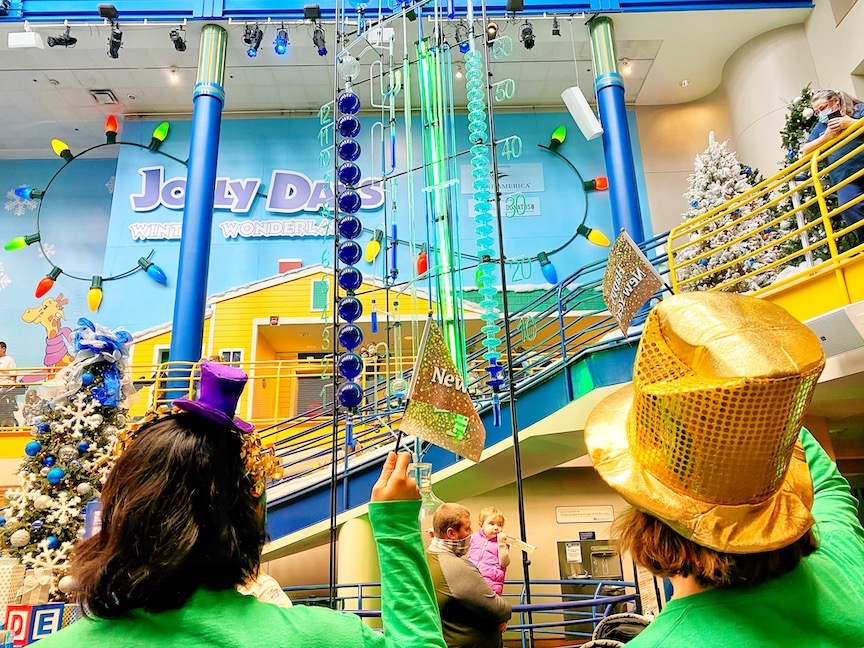
The Water Clock at the Indianapolis Children’s Museum is an attraction for kids and their parents. Photo courtesy of Indianapolis Children’s Museum
By Susan McKee
All eyes were on the Water Clock when I joined the scrum of parents and kids gathering in the Sunburst Atrium of the Children’s Museum of Indianapolis. It was a few minutes before 1 p.m., and we all were waiting for the “big show” at the top of the hour.
The kids hooted with delight as the twelve orbs on the left side (representing the hours) and the 29 discs on the right (each counting for two minutes) began to empty in a dramatic cascade to reset for the next 12-hour cycle. (The missing two minutes? That’s the time it takes for the pipes to drain.)
The young were caught up in the spectacle while the rest of us were puzzling out the mechanics of the clock (yes: there’s a pump hidden in the base). Designed by French physicist and artist Bernard Gitton, the Water Clock soars 26-1/2 feet high with 40 separate pieces of handblown glass and a hundred metal connectors using 70 gallons of a water, methyl alcohol and food coloring mixture to tell the time.
The best children’s museums transfix kids, introducing them and their attentive parents to the surrounding world.
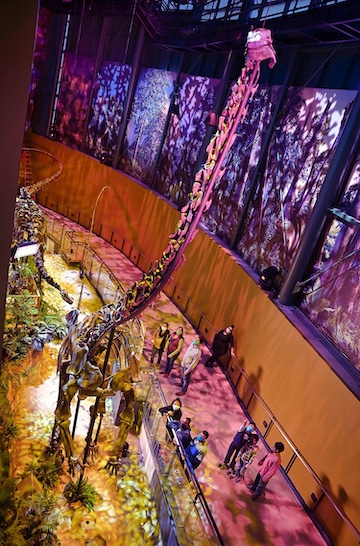
Visitors to the Indianapolis Children’s Museum leave with an appreciation of the size of dinosaurs like the sauropod, a species that proved you don’t have to eat meat tro grow big and strong. Photo courtesy of the museum
Teddy bears. Antique dolls. Miniature rooms. Toy trains chugging through detailed landscapes. All are staples at children’s museums nationwide. The Children’s Museum of Indianapolis has these, plus more, like the Water Clock that’s unique.
The Children’s Museum of Indianapolis – the largest in the world — involves youngsters in active play, teaching about the world experientially with “show me, don’t tell me” techniques.
It starts with those five and younger, who are welcomed to Playscape. There, they can splash about in the Water Table, build towers in Blockopolis and launch balls through the Reaction Contraption.
Many of the indoor exhibits across five floors are interactive, such as the Dinosphere, which includes full-size skeletons of the extinct beasts and treasures of the Earth, which introduces archaeological research techniques. There are always classic collections of items rotating through the exhibits in American POP such as cowboy boots and comic books. Take Me There: Greece schedules Greek dance lessons and food tastings in surroundings evocative of a Southern European village.
Dinosphere doesn’t stop with skeletons and dioramas. There’s a pretend “dig,” where young fossil hunters can search for bones, and a real laboratory with real scientists actually working on cleaning, preparing, studying, and researching real fossil bones dug up in ongoing excavations from a site in Wyoming.
Treasures of the Earth spotlights Ancient Egypt, China’s terra cotta warriors, and a Caribbean pirate shipwreck. Since COVID-19 closed Xi’an, China, to visitors, the Children’s Museum of Indianapolis is the best place to explore up close and personal these relics of the long-ago Qin dynasty (in replica form, of course).
There are always classic collections of items rotating through the exhibits in American POP such as cowboy boots and comic books. Take me there: Greece schedules Greek dance lessons and food tastings in surroundings evocative of a Southern European village.
Both kids and parents are drawn to Dale Chihuly’s Fireworks of Glass. The colorful extravaganza stands 43 feet — five stories — tall in the stairwell atrium, but don’t miss a look underneath. It’s on the lower level, beneath the sculpture, that you can see how the 3,200 stunning pieces of brilliant blown glass were created.
A restored carousel that once twirled in a city park now carries children (and adults under 150 pounds!) on musical journeys. Visitors can climb aboard the Reuben Wells – a 35-foot-long, 55-ton steam engine that used to make the journey up “the steepest railroad grade in the U.S.” as it chugged from down by the Ohio River up north to Indianapolis.
And I haven’t even mentioned the outdoor attractions. Everyone can take a turn at popular sports, including hockey, soccer, basketball, baseball, and even miniature golf on the 7.5-acre site adjacent to the Children’s Museum.
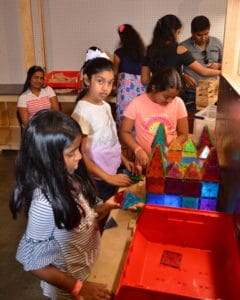
Children at the Frisco Discovery Center find plenty to provoke their curiosity. Photo by David DeVoss
More museums for kids
The Association of Children’s Museums includes more than 200 museums throughout the U.S. Here are some of the places to stop on your summer vacation that are perfect for youngsters.
Children’s Museums in the Central States
Chicago, Illinois: Museum of Science and Industry
I grew up in suburban Chicago, so my introduction to the world of museums was the Museum of Science and Industry, which first opened in 1933. It’s the largest science museum in the Western Hemisphere. Whether it’s a “working” coal mine, fairy tale doll house, World War II German submarine, or 13-foot-tall, animated, walk-through 3-D heart, there’s something for all ages (don’t miss the baby chicks in the hatchery or the world’s largest display of LEGO art).
Chicago, Illinois: Field Museum
The Field Museum covers natural history. Think animals, vegetables, and minerals along with cultural artifacts. Since the museum first opened in 1894 with items accumulated for the World’s Columbian Exposition, its collection has grown to nearly 40 million artifacts and specimens, including SUE, the largest and most complete Tyrannosaurus rex ever discovered.
Decatur, Illinois: Children’s Museum of Illinois
The Children’s Museum of Illinois, aimed at children ages two to ten, is packed with interactive experiences. One example: Seed to Shelf is a hands-on agriculture exhibit that traces the journey food takes– where it grows and how it gets to the shelves of the local grocery store. The newest exhibit (go inside an eyeball!) is all about eye health.
Pigeon Forge, Tennessee: WonderWorks
Six zones of family fun comprise WonderWorks from extreme weather to an indoor ropes course. It’s a big franchise. There are WonderWorks indoor “edu-tainment” sites in five other cities: Orlando and Panama City Beach, Florida; Myrtle Beach, South Caroline; Syracuse, New York, and Branson, Missouri.
Houston, Texas: Children’s Museum of Houston
Kidtropolis is a huge pretend city where kids run the show at the Children’s Museum of Houston, complete with its own city hall, bank, news center, and veterinarian’s office. The goal? Help kids understand occupations and economics. Budding inventors create their own gadgets and gizmos in the Invention Convention. The under-3 set can play in a padded area or roll around in a ball pit at Tot*Spot.
Frisco, Texas: Frisco Discovery Center
A rapidly expanding museum in one of Texas’ fastest growing towns, Frisco’s Discovery Center and National Video Game Museum has more than 100,000 artifacts, 75% of which are fully interactive. Adults are attracted to its Art Gallery and Black Box Theater, which hosts local theatrical performances. Children can spend hours in its science center or its new TrainTopia, which has 2,500-ft. of G-scale model trains that run through miniature worlds distinguished by scenery from different parts of the U.S. Children and adults together enjoy the video games.
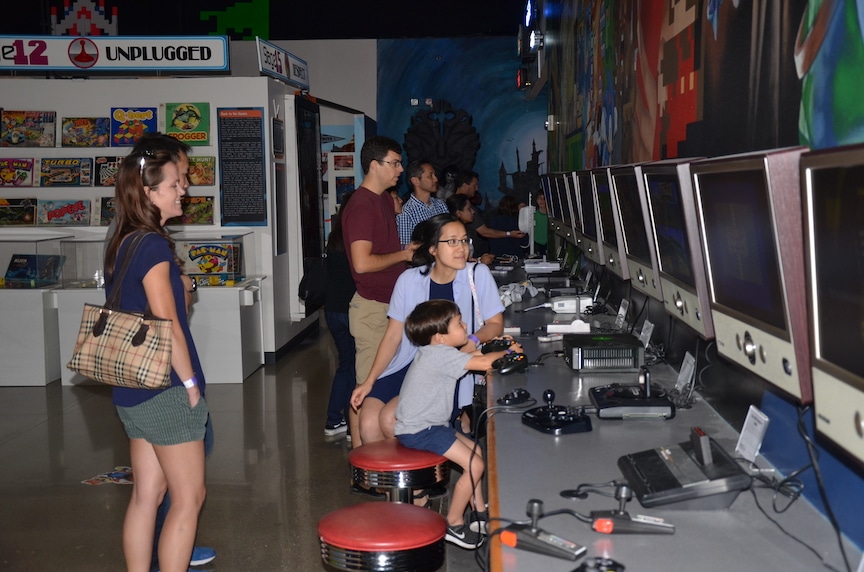
Both children and their parents enjoy playing video games at the Frisco. TX, Discovery Center. Photo by David DeVoss
Children’s Museums in the West
San Francisco, California: Exploratorium
The Exploratorium isn’t a children’s museum per se, but it is designed to expand on the science education kids get in school. Create a marble maze or build something with cardboard. Learn about the weather or explore your senses with gigantic mirrors.
Denver, Colorado: Children’s Museum of Denver
This museum has a three-story climbing experience and a place to build trucks and design helicopters, but don’t forget the bubbles. Kids of all ages will find all sorts of interactive ways to discover the soapy science secrets behind floating, shimmering bubbles including a chance to make your own bubbles bigger than yourself.
Colorado Springs, Colorado: Pikes Peak Children’s Museum
Purposeful play is promised at this community-built destination. Hands-on experiences with physics, for example, include making a paper airplane in the Outer Space Room. Math skills are put to the test in Simple Machines. Farm to Fork looks at how food gets produced, distributed, prepared, and served.
Children’s Museums in the East
New York City: American Museum of Natural History
The Museum, founded in 1869, is renowned for its wide-ranging exhibitions and scientific collections, which serve as a “field guide” to the planet and present a panorama of the world’s cultures. Its collection of exhibits includes six Fossil Halls with all sorts of dinosaurs plus gigantic but extinct mammals. In fact, almost “everything” is somewhere in its two million square feet of space.
Baltimore, Maryland: Port Discovery Children’s Museum
Budding artist? Adventurer? Future entrepreneur? Soccer player? Sleuth? There’s something for every kid at this variety-filled location. If your child is younger than six, plan to visit on Wonderful Wednesdays, which offers a morning packed full of age-appropriate activities that focus on music, literacy, and early learning.
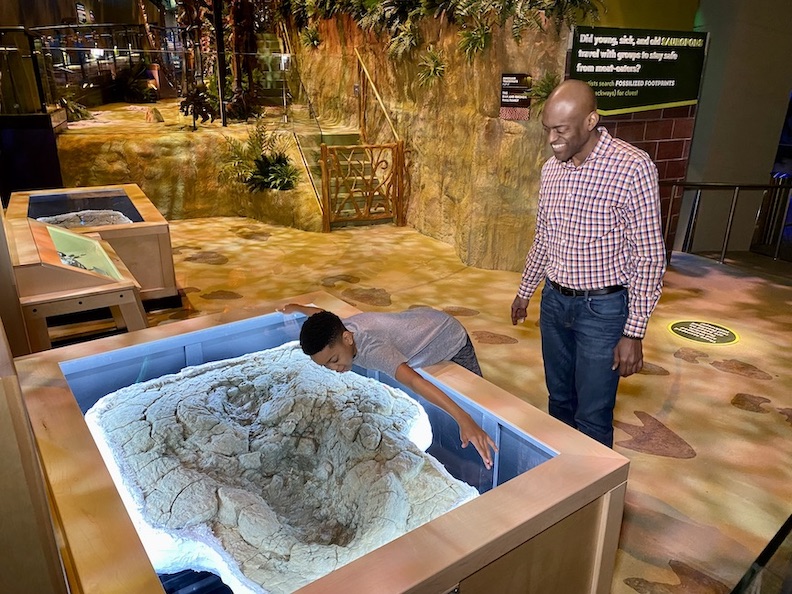
It’s sooo big! A fossilized footprint of a sauropod at the Indianapolis Children’s Museum allows children to appreciate the enormous size of dinosaurs. Photo by Indianapolis Children’s Museum
Philadelphia, Pennsylvania: Please Touch Museum
The name says it all. Each section of this two-story museum has hands-on learning opportunities that also are completely fun. There’s a train station, Alice in Wonderland exhibit and a Fairytale Garden as well as a real 1924 carousel.
Boston, Massachusetts: Boston Children’s Museum
There’s a special play zone for kids aged three and under and a Countdown to Kindergarten room, where preschoolers can get a feel for what a big-kid classroom will be like. Older kids can create a hideaway in Fantastic Forts. Each exhibit area in Explore•a•Saurus presents direct evidence about some aspect of dinosaur anatomy or behavior, then encourages visitors to analyze that evidence and develop their own theories based on the evidence.
Passing through a city not on this list with a car full of children. Then check out the Find a Children’s Museum website. There may be a day’s worth of family fun close to you.![]()
Susan McKee roams the world from her base in Indianapolis. Her previous stories for EWNS were about European Christmas markets and Armenia.

